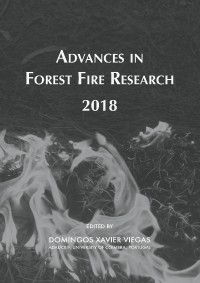Please use this identifier to cite or link to this item:
https://hdl.handle.net/10316.2/44536| DC Field | Value | Language |
|---|---|---|
| dc.contributor.author | Vilar, Lara | |
| dc.contributor.author | Garrido, J. | |
| dc.contributor.author | Herrera, S. | |
| dc.contributor.author | Bedia, J. | |
| dc.contributor.author | Yebra, M. | |
| dc.contributor.author | Echavarría, P. | |
| dc.contributor.author | Martín, M. P. | |
| dc.date.accessioned | 2018-11-09T11:51:03Z | |
| dc.date.accessioned | 2020-09-06T17:31:07Z | - |
| dc.date.available | 2018-11-09T11:51:03Z | |
| dc.date.available | 2020-09-06T17:31:07Z | - |
| dc.date.issued | 2018 | - |
| dc.identifier.isbn | 978-989-26-16-506 (PDF) | |
| dc.identifier.uri | https://hdl.handle.net/10316.2/44536 | - |
| dc.description.abstract | This study aims to estimate wildfire occurrence in two representative Spanish regions with different territorial, social and environmental characteristics as well as fire history; Zamora and Madrid. Land-Use Land Cover (LULC) interfaces derived from ESA Climate Change Iniciative-Land Cover (CCI-LC) 2005 (covering 2003-2007 period at 300m resolution) were used as indirect indicator of socio-economic drivers associated with human-caused wildfire ignition sources. Three general interfaces were used; forest-agricultural interface (FAI), grassland-forest interface (GFI) and wildland urban interface (WUI), as well as other more specific ones derived from a disaggregated LULC legend. A set of biophysical variables including orientation, monthly precipitation, temperature (mean, minimum and maximum) as well as live fuel moisture content (FMC) were also considered in the model. Monthly precipitation and temperature were obtained from a regional climate dataset developed for the study sites by the University of Cantabria (Spain) at 1km2 spatial resolution while FMC were calculated from MODIS images following Yebra et al. (2018) methodology. Orientation was obtained from the Digital Terrain Model at 25m available for Spain at the Spanish National Geographic Institute (CNIG). Generalized Linear Models (GLMs) were used to obtain four sub-models to estimate wildfire occurrence in the two study regions during the 2000-2010 period. Two models included only LULC interfaces at two different disaggregation levels, and the other two models also included biophysical drivers. Results showed that disaggregated interfaces helped to improve the spatial characterization of probability of occurence. FAI was the LULC general interface that contributed the most to the models. Biophysical drivers had larger contribution to the models than the interfaces but the later still had importance explaining the spatial distribution of the fire occurrence probability. The accuracy of the models improved when biophysical variables were included achieving a sensitivity of~42% and omission errors of ~58% in Zamora and ~6% and 90%, respectively in Madrid. The results for Madrid were less accurate mainly due to the small number of fire events to fit the models. Future works will deal with modeling in areas with small but of importance number of fires as in this last site. This study indicates that the human component of wildfires represented by LULC interfaces and its disaggregation can be integrated into wildfire occurrence estimation. | eng |
| dc.language.iso | eng | - |
| dc.publisher | Imprensa da Universidade de Coimbra | por |
| dc.relation.ispartof | http://hdl.handle.net/10316.2/44517 | por |
| dc.rights | open access | - |
| dc.subject | CCI-Land Cover | eng |
| dc.subject | LULC interfaces | eng |
| dc.subject | MODIS Hotspots | eng |
| dc.subject | wildfires | eng |
| dc.title | Wildfire occurrence estimation in Spanish regions based on Land Use-Land Cover interfaces and biophysical variables | por |
| dc.type | bookPart | por |
| uc.publication.firstPage | 192 | - |
| uc.publication.lastPage | 200 | - |
| uc.publication.location | Coimbra | por |
| dc.identifier.doi | 10.14195/978-989-26-16-506_19 | - |
| uc.publication.section | Chapter 1 - Fire Risk Management | por |
| uc.publication.digCollection | PB | por |
| uc.publication.orderno | 19 | - |
| uc.publication.area | Ciências da Engenharia e Tecnologias | por |
| uc.publication.bookTitle | Advances in forest fire research 2018 | - |
| uc.publication.manifest | https://dl.uc.pt/json/iiif/10316.2/44536/203987/manifest?manifest=/json/iiif/10316.2/44536/203987/manifest | - |
| uc.publication.thumbnail | https://dl.uc.pt/retrieve/11056873 | - |
| uc.publication.parentItemId | 55072 | - |
| uc.itemId | 68791 | - |
| item.grantfulltext | open | - |
| item.fulltext | With Fulltext | - |
| Appears in Collections: | Advances in forest fire research 2018 | |
Files in This Item:
| File | Description | Size | Format | |
|---|---|---|---|---|
| wildfire_occurrence_estimation_in_spanish_regions.pdf | 844.67 kB | Adobe PDF |  |
Items in DSpace are protected by copyright, with all rights reserved, unless otherwise indicated.
